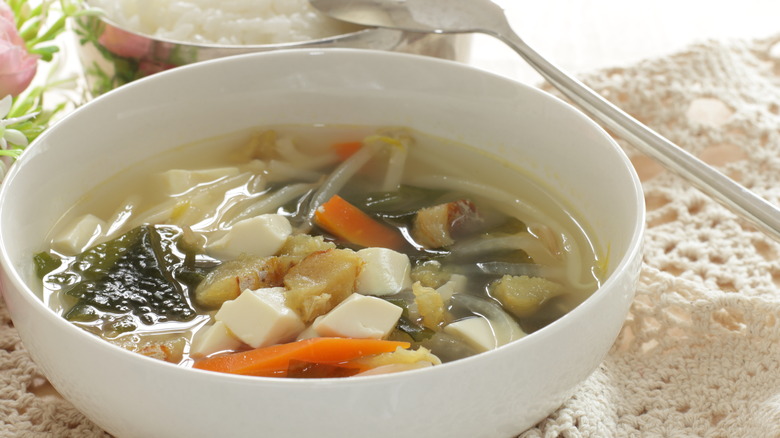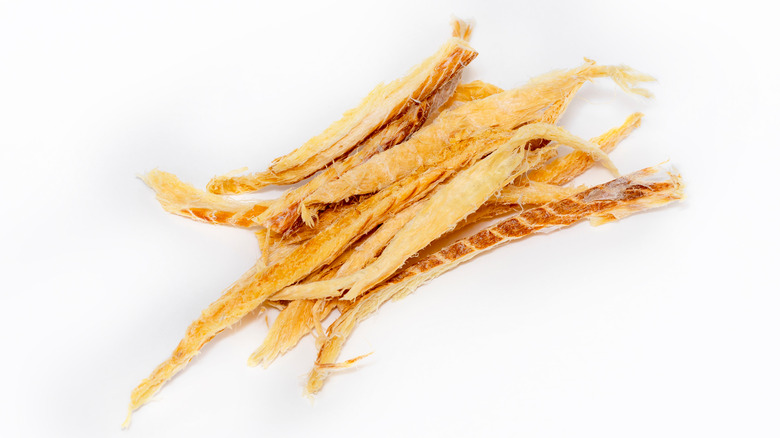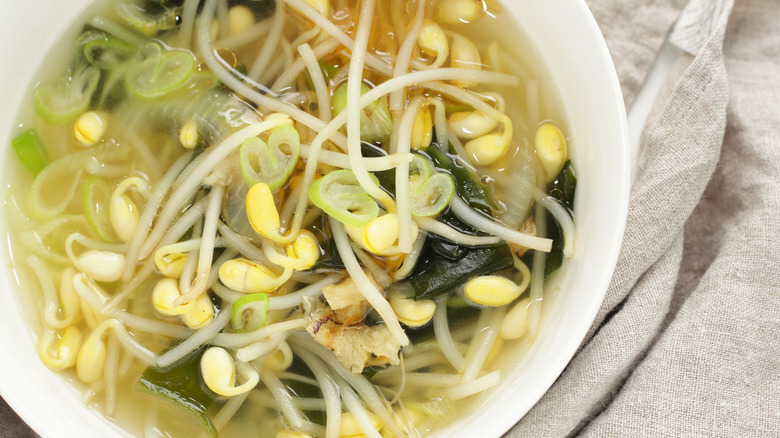Bugeoguk: The Simple Korean Soup Made With Dried Pollock
Sometimes simple is best. When it comes to bugeoguk, a soup made with dried pollock, that is certainly the case. Koreans enjoy many kinds of dried seafood, including anchovies and squid, which are part of the large selection at Seoul's Chungbu Market, according to The Korea Herald. They have dried fish since about the 10th century. The traditional practice has involved removing the water from the fish, hanging it to dry, and allowing the sun and wind to help with the drying process.
The best dried pollock for bugeoguk, per Maangchi, is named hwangtae and is dried naturally by being hung outside where the sea breeze can dry it. She says this drying method allows for the fish to freeze at night and then thaw during the day throughout the multi-day process, allowing for the final product to be flaky and spongy. The name of the soup itself translates to pollock (bugeo) soup (guk), according to Kimchimari.
Only a handful of ingredients
In addition to dried pollock, common ingredients found in bugeoguk are Korean radish or daikon, sesame oil, garlic, fish sauce, tofu, green onions, and eggs (per Maangchi). When the pollock is added to the pot, it is torn into thin strips about 2 ½ inches long. Korean Bapsang uses a different method of making the soup. Strips of dried pollock are first reconstituted in warm water for about 20 minutes before being cut into bite-size pieces.
A recipe from Kimchimari includes five cups of anchovy stock. When it comes to selecting the dried pollock, Kimchimari recommends buying pieces that are neither too hard nor too dry so that they have the most flavor. Some optional ingredients are dried red chili pepper or red chili powder to add some heat. Adding tofu or bean sprouts will give the soup some additional flavor and texture, per Kimchimari. Also, if a person doesn't have anchovies for the broth, then water can be used. Another bit of advice that Kimchimari shares is that if the flavor of the soup is bland, add more dried pollock or garlic.
An invigorating soup
Bugeoguk is one of the most common and frequently eaten soups in Korea, Maangchi says. It's popular as a meal to be eaten after a night of drinking to treat a hangover and is believed by some to help increase energy. Maangchi writes that bugeoguk is also thought to help detoxify a person's body and may have other health benefits.
The soup is served for many different occasions, even when President Barack Obama met with South Korean President Lee Myong-bak during a visit to Seoul in 2009, Korean Bapsang says. For those lacking the time to make bugeoguk from scratch, there is a more convenient packaged instant version. Ottogi Instant Dried Pollock Soup is sold online by Seoul Mills. The packaged soup is described as being made from a dried fish base.
Koreans often say that eating bugeoguk is "shewonhada," which Kimchimari says means "invigorating" or "refreshing." By this, they mean that the soup can be felt as it goes from the mouth to the stomach. Despite having dried pollock as a main ingredient, Korean Bapsang says the soup does not have a fishy taste. By sautéing the dried pollock, which has been soaked, in sesame oil, its flavor is enhanced. If you are looking for a warming and invigorating soup that is classically Korean, you may want to give bugeoguk a try.


